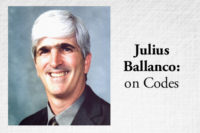Issue: 10/02
Editor's Note: We offer "Sound Off" as an open forum for industry professionals to express their opinions about industry issues, as well as to offer advice to our readers on how to manage their businesses. To submit material for this column, contact Kelly Johnson at johnsonk@bnp.com.
Any but the most cynical observer has to be feeling sorry for the marketing folks at the National Fire Protection Association these days. NFPA's attempted invasion of the building code publishing world, launched by immediate past CEO, retired Air Force Lt. Gen. George Miller, has put the association in the position of having to foster a disingenuous propaganda battle to win the hearts and minds of the state and municipal authorities responsible for adopting construction codes in their jurisdictions.
While the NFPA marketing team is widely acknowledged as a group of superior performers, they have been burdened from the beginning of the code wars by a lack of ammunition. From the beginning, when industry comments ran 10 to 1 against the development of another building code in response to the NFPA project initiation notice, NFPA has never identified a sound public policy reason for the non-profit association to pursue this action. As a result, NFPA's propagandists have been forced to support their initiative with innuendo, distortions and unsupported claims. NFPA's much vaunted "true consensus" process has also taken some serious hits as a result of this battle. Whether NFPA's ability to fulfill its mission to reduce the worldwide burden of fire and other hazards on the quality of life has also suffered collateral damage is now subject to speculation.
The true consensus argument, the keystone of NFPA's marketing attack and the one employed to justify the questionable business decision to compete with the International Code Council's set of International Codes, is prone to backfire. By touting its process, NFPA has invited the world to examine "true consensus" as they define it, and many have found it truly flawed.
It seems that every few years the association's marketing folks get stuck with explaining a backfire in the true consensus process as NFPA pursues its business goals at the expense of both fire safety and sound public policy. In 1997, it was the Standard Council overturning an assembled membership vote to limit the installation of large volume propane storage facilities on the roofs of tall buildings as an unsafe practice. In 2001, it was the Standards Council's acceptance of the vote packing actions of the International Association of Fire Fighters at the NFPA annual meeting in Anaheim to secure passage of increased fire department staffing through NFPA 1710. This year, it's the Standard Council's decisions to once again overturn the assembled membership and strike down requirements for elevator lobbies, as well as fire suppression in one-and two-family dwellings.
Of course, as the marketers know, the Achilles' heel of NFPA's consensus process is not only that the 13 members of the Standards Council can determine the content of the association's codes and standards, but that they can determine that content behind closed doors. Local politicos, used to complying with restrictions imposed by open meeting laws, aren't generally receptive to the NFPA consensus process once they know the details.
Nonetheless, NFPA's troops continue to claim that the association has the only process-producing construction codes that comply with federal regulations for suitability of reference. They continue to make that claim despite federal agency adoptions of numerous codes and standards not accredited by the American National Standards Institute, including codes produced under the ICC's governmental consensus process.
Of course, all's fair in today's code wars, and now NFPA advocates are also popping up in multiple venues to declare NFPA 5000 as the only building code to address fire fighter safety. They make this assertion despite inclusion of emergency responder provisions in the scope of the International Building Code by the hearing committee at last April's ICC code hearings in Pittsburgh. It will be interesting to see how those same folks explain to the fire service the impact on fire fighter safety of the Standards Council's action on residential sprinklers.
NFPA may also have a tough time explaining the residential sprinkler decision to its allies in the piping trades. Residential sprinkler requirements in NFPA 5000 would have been an enormous windfall in labor hours to the pipe trades. Considering that the primary reason the City of Phoenix is moving toward adoption of NFPA 5000 is due to the pipe trades' political influence in that city, they must feel that the NFPA Standards Council decision is a betrayal.
It will also be interesting to see how NFPA, a newborn in the building code arena, will make good on their marketing claims of being able to provide building code technical support to adopting jurisdictions. They have never provided product evaluation services, building code interpretative services or building inspection certifications in the past. Fortunately for them, given the likely adoptions of this edition of the code, there won't be much demand for those services, and the fire service won't have to worry about NFPA diverting further fire prevention resources into building code support for now.
"Comprehensive" is another adjective attached to NFPA 5000 by NFPA marketers. That would explain why the document delivered to the Standards Council referenced so many undated standards. Apparently it's permissible to use any edition of those standards. Or, as in the case of aluminum construction, any available standard may be used. These are the contents of Chapter 41, Aluminum: "Aluminum construction shall be designed and constructed in accordance with approved standards." Now that's comprehensive!
You must have some sympathy for the folks stuck with marketing the NFPA 5000 effort. They've been given a sow's ear and were told to sell silk purses. It's the toughest job in the code business, and it is a testament to their skill that at least one city seems to be willing to buy it.

